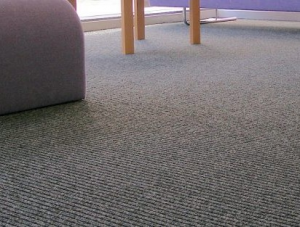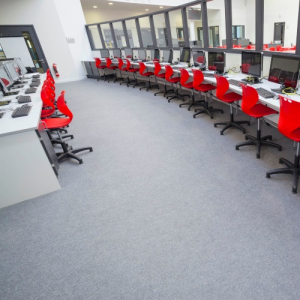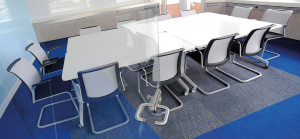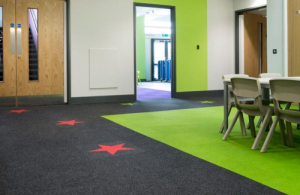HECKMONDWIKE FB LTD
Suppliers of: Contract Carpets, Commercial Carpet, Entrance Matting, Barrier Matting, Carpet Tiles, Office Carpets, Carpet for Schools, Contract Flooring
Heckmondwike FB Leading UK manufacturers of Fibre Bonded Carpet, Carpet Tiles & Entrance Matting.
Heckmondwike FB began manufacturing carpets in 1967 and today is firmly established as the leading, specialist manufacturer of heavy contract fibre bonded carpet and carpet tiles.
The current range includes an extensive selection of stylish heavy duty contract carpet options all designed and produced at Wellington Mills, which houses one of the most modern fibre bonded production plants in Europe. We have a strong heritage of tradition and workmanship behind us, which is why our products stand the test of time.
- Manufacturing high quality products through ISO 9001 accreditation
- Delivering maximum environmental responsibility through ISO 14001 accreditation
- Supporting our customers with technical advice and after sales assistance
- Building strong partnerships with our supply chain
From market leading Supacord to the innovative Montage, Heckmondwike FB delivers a range of carpets and carpet tiles that exceeds expectations. Schools, colleges, universities and local authorities across the UK have been choosing carpets from Heckmondwike FB confident in the quality, design and performance.
Along with our range of specialist entrance area carpets and tiles, our products can be used throughout the building to create outstanding floor designs that withstands heavy footfall and traffic. Our contract carpet ranges have enhanced acoustic properties that reduce noise transmission and is anti-static making them suitable for rooms with PCs. Our ranges are cost-effective and designed for easy installation and maintenance.
Carpets for Schools & Education
Heckmondwike’s web site aides any educational specifier or school in choosing, installing and maintaining a carpet. Our website helps explain what you should be looking for when specifying a school carpet, how to install and maintain one but also importantly why a Heckmondwike carpet is the ideal carpet for educational purposes.
With case studies, interactive product selector and design tool, How to Guides and much more. Heckmondwike provide you the information to help you make your specification decision and install the correct carpet that is fit for purpose.
Carpets for Commercial Properties
For specifying and purchasing carpets for commercial properties Supacord is the commercial flooring that is the perfect carpet for use in public spaces, such as offices, entrance areas and corridors. Supacord has an A+ rating from BRE and thermal properties to effectively conserve heat. Supacord is also antislip, antistatic and extremely durable, yet remains highly cost competitive.
Available in 2 metre and 4 metre wide sheet material as well as 50 x 50cm carpet tiles and available in a wide range of colours and shades. Tested to BS4790, BS EN 13501:2002 with excellent acoustic properties, Supacord has been installed in thousands of public buildings and has a proven record.
Entrance Area Carpets and Carpet Tiles
Heckmondwike entrance area carpet and carpet tiles are perfect for areas of heavy wear and tear. Not only do they look attractive. They also act as interceptors, protecting carpets from dirt and moisture trodden in off the street. Our ranges come in a wide selection of colours and finishes.
Carpets & The Environment.
As a company we are committed to environmentally responsible business practices. We comply with current, relevant environmental legislation and have full accreditation to BS EN ISO 14001: 2004 and appropriate industry codes of practice. Our products certified by BRE Global for Environmental profiles.
We integrate environmental management system practices with existing quality, health, safety and business management systems. We minimise the adverse environmental impacts of waste generation and promote the safe and responsible disposal of waste.
Heckmondwike FB - 5 Proven Ways to Improve Inclusion in Schools
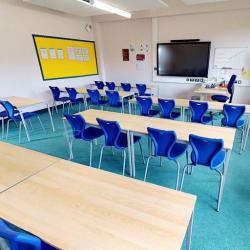 Inclusion in schools in the UK is gaining momentum, but data shows there’s still a long way to go. As of early 2024, nearly 1.7 million pupils in England (18.4%) are identified as having special educational needs or disabilities (SEND). At Key Stage 2, only 14% of children with SEND reached expected standards in reading, writing, and maths, compared to 62% of non-SEND peers.
Inclusion in schools in the UK is gaining momentum, but data shows there’s still a long way to go. As of early 2024, nearly 1.7 million pupils in England (18.4%) are identified as having special educational needs or disabilities (SEND). At Key Stage 2, only 14% of children with SEND reached expected standards in reading, writing, and maths, compared to 62% of non-SEND peers.
This persistent attainment gap underscores why fostering inclusive school environments is not just progressive, it’s essential. Schools are moving away from segregated models and toward inclusive classrooms where students of all abilities and backgrounds learn together.
The Evolution of Inclusive Education
Inclusive education isn’t just a principle; it’s backed by research. Students with disabilities achieve better academic and social outcomes in mainstream settings, and children with autism are six times more likely to engage socially when included. Their peers also benefit, gaining empathy, collaboration, and problem-solving skills. But inclusion goes beyond sharing space, the physical and sensory environment matters.
This blog explores five proven environmental design strategies that support meaningful inclusion and enhance learning for every student.
5 Key Features of Inclusive Classroom Design
Acoustic Design
In mainstream UK schools where over 90% of pupils with SEN are enrolled, managing sensory input is vital.
Noise can be overwhelming for many students, especially those with sensory sensitivities, autism, anxiety, or other neurodivergent needs. Creating quiet zones or calm-down areas provides low-stimulation spaces where students can retreat, self-regulate, and return to learning when they’re ready.
Using acoustic carpet tiles in these spaces further enhances their effectiveness. These carpets absorb sound, reducing overall noise levels and creating a more peaceful environment.
This isn’t just beneficial for emotional regulation, it also supports students with hearing impairments by minimising background noise and improving sound clarity.
Together, quiet zones and acoustic flooring offer a powerful way to support emotional well-being and learning focus in an inclusive setting.
Visual Contrast: Enhancing Safety and Independence
In an inclusive school, clear visual contrast in flooring helps students move safely and confidently through the space. For students with visual impairments, cognitive disabilities, or developmental delays, subtle level changes like steps or thresholds can pose a risk. Using contrasting colours or textures highlights these transitions, reducing trips and falls.
Visual contrast also supports independence. It gives students clear, consistent visual cues to understand boundaries and navigate without constant assistance. For example:
Dark strips can mark the edges of steps
Lighter colours can highlight doorways or designated pathways
Combining visual contrast with tactile flooring further supports students who use touch for navigation, creating a more accessible environment for everyone.
Colour-Coded Flooring: Simple Navigation for All
Colour-coded flooring is another practical tool for inclusive design. Using different colours for specific areas—such as classrooms, corridors, or quiet zones—helps all students navigate school spaces more independently.
This is especially useful for:
Students with SEND, autism, or anxiety
Non-verbal students or those learning English as an additional language
Younger children who can’t yet read signage
Colour coding offers a predictable and visual system that reduces confusion, supports independence, and builds confidence.
Case Study: Bedale School, North Yorkshire
Bedale High School has embraced colour-coded flooring as part of its inclusive design strategy. The school recently installed blue and purple carpet sections in corridors and classrooms to help students navigate the building more easily.
This colour system supports SEND students and those who may struggle with verbal instructions or reading signage.
The school plans to install additional colours to expand this practical approach, aiming to create an even clearer, more accessible environment that fosters independence and confidence for all learners.
Blue carpet is installed in the school corridor with blue inspirational wall designs
Blue Array and Broadrib carpet installed in corridors to support navigation and reduce anxiety for SEND students
Purple Broadrib borders and Array tiles have been installed in the school's corridors to match the wall designs
Purple flooring in Array and Broadrib used to create clear, visual cues for inclusive and accessible wayfinding
Soft, Neutral Colours: Creating a Calming Environment
While bright colours can be stimulating, soft, neutral tones like pastel blues, greens, or lavenders have a soothing psychological effect. These colours help reduce sensory overload and support focus, particularly for students with autism or anxiety.
Case Study: Kents Hill Park Secondary School, Buckinghamshire
This school serves both secondary and SEN students. Over 2,300 square metres of Supacord carpet tiles were installed in a light blue tone.
According to colour psychology, blue is considered one of the most effective colours for learning. It is commonly associated with calmness, tranquillity, and emotional regulation, making it especially beneficial for students who need to concentrate on more demanding tasks.
This is particularly important in an SEND setting, where many students, especially those with autism or anxiety, benefit from environments that help reduce sensory overload.
In addition, light blue carpets reflect natural light well, helping classrooms feel brighter and more open without creating a harsh or overstimulating environment.
For neurodivergent learners, this balance is essential in supporting focus and reducing impulsivity.
Light blue carpet installed in an ICT suite in a a secondary school
Supacord carpet in a lighter blue colourway in the IT suite promotes calmness and focus for secondary and SEN students
Light blue carpet installed in a school classroom with dark blue chairs and wooden desks
Soft blue flooring creates a soothing, sensory-friendly environment supporting neurodivergent learners’ concentration
Cleanliness and Maintenance: Supporting Health and Consistency
In large schools, maintaining a clean, hygienic environment is vital, especially for students with asthma, allergies, or sensory sensitivities. Flooring must be easy to clean and maintain to ensure a healthy space for everyone.
Case Study: Northstowe Education Campus, Cambridgeshire
This award-winning campus supports around 3,000 students across primary, secondary, sixth form, and SEN facilities. With 4,700 square metres of Supacord carpet tiles installed, the school benefits from flooring that is not only durable but also easy to maintain.
This ensures learning environments stay clean, safe, and visually consistent, even in high-traffic areas.
Supacord in Steel installed in an empty school library
Durable and easy-to-maintain grey Supacord carpet in the school library supports a clean, safe, and welcoming learning environment for those who are sensory sensitive
Building Classrooms for Every Learner
Inclusive classroom design isn’t just a trend; it’s a commitment to meeting the needs of every learner.
By investing in inclusive classroom design, you’re addressing both academic gaps and social development, backed by evidence from real UK schools.
Get in touch today to learn how our inclusive flooring solutions can help transform your learning spaces into places where every student feels safe, supported, and ready to succeed.
FAQ:
Q1: What is inclusive education?
Inclusive education ensures that all students, regardless of their physical, intellectual, social, or linguistic differences, have access to quality education in mainstream settings.
Q2: What is an inclusive classroom?
An inclusive classroom is a general education setting where students with and without disabilities learn together, supported by flexible teaching strategies and an accessible environment.
Q3: Is inclusion effective in schools?
Yes! Research shows inclusive classrooms boost academic success, self-esteem, and social skills for students with disabilities, while also promoting empathy and teamwork in all students.
Q4: What are the features of an inclusive classroom?
Inclusive schools provide accessible facilities, adapted teaching methods, supportive staff, and foster a culture of respect and diversity for all learners.






